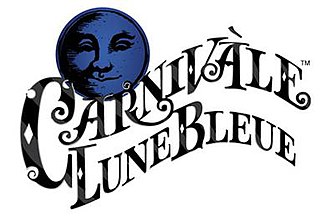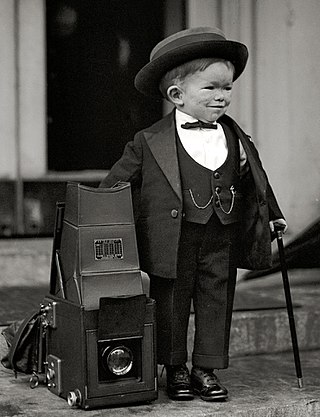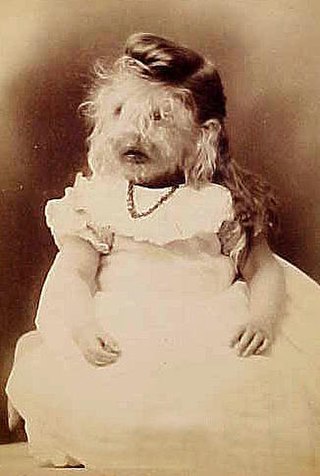
Gibsonton, sometimes nicknamed Gibtown, is an unincorporated community and census-designated place in Hillsborough County, Florida, United States. U.S. Route 41 runs through the center of the community. The population was 18,566 at the 2020 census, up from 14,234 at the 2010 census.

A circus is a company of performers who put on diverse entertainment shows that may include clowns, acrobats, trained animals, trapeze acts, musicians, dancers, hoopers, tightrope walkers, jugglers, magicians, ventriloquists, and unicyclists as well as other object manipulation and stunt-oriented artists. The term circus also describes the field of performance, training and community which has followed various formats through its 250-year modern history. Although not the inventor of the medium, Newcastle-under-Lyme born Philip Astley is credited as the father of the modern circus.

William Henry Johnson, known as Zip the Pinhead, was an American freak show performer known for his tapered head.
The Jim Rose Circus is a modern-day version of a circus sideshow. It was founded in Seattle in 1991 by Jim Rose and his wife BeBe Aschard Rose. The sideshow, then called the "Jim Rose Circus Sideshow", came to prominence to an American audience as a second stage show at the 1992 Lollapalooza festival. although they had toured the Northwest and Canada and had several US TV appearances before this time. Rolling Stone magazine called the show an "absolute must-see act" and USA Today termed Rose's troupe "Lollapalooza's word-of-mouth hit attraction".

Aloisia Wagner, better known by her stage name Violetta, was a German-American woman who was born without legs or arms with a condition known as tetra-amelia syndrome. She was born in Hemelingen, Germany, and had a lengthy career in sideshow performance.

Horace Leonard Ridler was a professional freak show and sideshow performer, exhibited for his heavy tattoos under the stage names The Great Omi and The Zebra Man.

Minnie Woolsey, billed as Koo-Koo the Bird Girl, was an American side show entertainer, best known for her only film appearance in Tod Browning's film Freaks in 1932.

A traveling carnival, usually simply called a carnival, travelling funfair or travelling show, is an amusement show that may be made up of amusement rides, food vendors, merchandise vendors, games of chance and skill, thrill acts, and animal acts. A traveling carnival is not set up at a permanent location, like an amusement park or funfair, but is moved from place to place. Its roots are similar to the 19th century circus with both being fitted-up in open fields near or in town and moving to a new location after a period of time. In fact, many carnivals have circuses while others have a clown aesthetic in their decor. Unlike traditional Carnival celebrations, the North American traveling carnival is not tied to a religious observance.

A human blockhead is a carnival or sideshow performer who hammers a nail or other implement into their nasal cavity via the nostril.

Schlitzie, possibly born Simon Metz and legally Schlitze Surtees, was an American sideshow performer. He also appeared in a few films, and is best known for his role in the 1932 movie Freaks. His lifelong career on the outdoor entertainment circuit as a major sideshow attraction with Barnum & Bailey, among others, made him a popular cultural icon.
Geek shows were an act in traveling carnivals and circuses of early America and were often part of a larger sideshow.

Carnivàle Lune Bleue is a live entertainment event in Ottawa, Canada. It was created by Executive Producer and Founder, Wayne Van De Graaff. Van De Graaff has stated that after watching the HBO series, Carnivàle, he was inspired to pursue his lifelong dream and recreate a vintage Depression-era carnival.

A freak show is an exhibition of biological rarities, referred to in popular culture as "freaks of nature". Typical features would be physically unusual humans, such as those uncommonly large or small, those with intersex variations, those with extraordinary diseases and conditions, and others with performances expected to be shocking to viewers. Heavily tattooed or pierced people have sometimes been seen in freak shows, as have attention-getting physical performers such as fire-eating and sword-swallowing acts.

Harry Lewiston was an American showman, freak show director, and barker. He wrote his memoirs under his stage name, published posthumously in 1968 as Freak Show Man: the Autobiography of Harry Lewiston, as told to Jerry Holtman.
Carnival Diablo the Ultimate Sideshow is a travelling sideshow operating primarily in Spencerville, Ontario, Canada. Performances by the troupe follow a traditional Ten-in-One format featuring such acts as fire-eating, sword swallowing and a human blockhead, with show times lasting two and a half hours. Carnival Diablo opened on April Fools' Day 1992 by Scott McClelland, whose family goes back three generations in the carnival and side show business. Shows have been performed across Canada, including shows at The Calgary Stampede, Edmonton's Klondike Days Regina's Buffalo Days, and the Canadian Tulip Festival. In 2008 and 2009, Carnival Diablo was a featured act at Carnivàle Lune Bleue, a dedicated revival of a 1930s old-time carnival located in Ottawa, Ontario.

Jones' Fantastic Museum was a family-oriented museum filled with a unique collection of weird and amazing inventions, strange sideshow attractions, old-time dime museum machines and antique exhibits, originally located in Snohomish County, and later in Seattle, Washington, United States, from 1963 to 1980. It was created by avid collector Walt a.k.a. Doc Jones.

Eli Bowen was an American sideshow performer known as "The Legless Wonder", or "The Legless Acrobat". He was also billed as "The Handsomest Man in Showbiz" and the "Wonder of the Wide, Wide World". His peak weight was 140 pounds (64 kg); his height was 24 inches (61 cm).

Clarence Chesterfield Howerton, also known as Major Mite, was an American circus performer who starred in the sideshow for over 25 years, 20 of which were with the Ringling Bros. and Barnum & Bailey Circus. He was 2 ft 4 in (0.71 m) tall and performed with several groups from the early 1920s through the late 1940s, billed as the smallest man in the world. His small physique was often contrasted alongside larger circus sideshow acts, such as the juvenile obese and the excessively tall.

The California Institute of Abnormalarts - also written as the California Institute of Abnormal Arts and abbreviated as CIA - was a nightclub and sideshow museum located in North Hollywood, California. Owned and operated by actor-screenwriter Carl Crew and Robert Ferguson, the venue primarily hosted underground musical groups, performance art, movie screenings and sideshow acts including burlesque and freak shows. The club closed in July 2022.

Alice Elizabeth Doherty was an American woman born with the condition hypertrichosis lanuginosa.



















